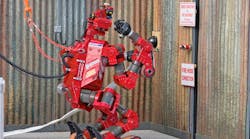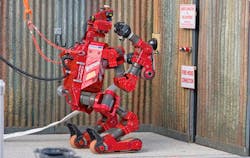As disasters and other emergencies get more dangerous, first responders are looking to robotic solutions that can save lives without putting personnel in danger. In an effort to encourage innovation, the Defense Advanced Research Projects Agency (DARPA) invited teams from academia and the industry alike to participate in its DARPA Robotics Challenge (DRC) Trials.
Held in December at the Homestead Speedway in Homestead, Fla., the competition simulated what robots might have to do to safely enter and effectively work inside a disaster zone while their operators stay out of harm’s way. Sixteen teams participated in the event, which consisted of eight tasks including walking across rough terrain, opening doors, locating and closing leaking valves, and even driving and exiting a vehicle (see the figure).
“At the start of the event, I said that I would be thrilled if even one team scored half the points available,” said Gill Pratt, DARPA program manager for the DRC. “The event exceeded my expectations multiple, multiple times over, with the top teams each scoring half or more.”
After two days of competition, DARPA chose eight teams to receive up to $1 million in funding to continue their work. SCHAFT Inc. of Tokyo took first place, followed by IHMC Robotics, Tartan Rescue of Carnegie Mellon University, Team MIT, RoboSimian of the NASA Jet Propulsion Laboratory, TRACLabs Inc., the WPI Robotics Engineering C-Squad of Worcester Polytechnic Institute, and Team Trooper of Lockheed Martin Advanced Technology Laboratories.
“The DRC Trials demonstrated the difficulty of having robots conduct seemingly simple tasks in real-world situations, and the participation of the first responder community provided an important illustration of how technology can save lives,” said Brad Tousley, director of DARPA’s Tactical Technology Office. “This event was yet another example why challenges work to attract new ideas and help quickly advance technology to solve a focused need.”
The teams now will prepare for the DRC Finals sometime in the next 12 to 18 months. The Finals will be an opportunity for the 16 teams to continue their efforts next to new teams to vie for the DRC’s $2 million prize. And already, Pratt has identified three initial goals for the next competition.
“First, we’d like the robots to be more stable so they don’t fall, and if they do fall, be more robust so they won’t break,” he said. “Second, have the robots work without their tethers by using wireless communication and more efficient, self-contained power systems. Finally, we’d like the robots to use more task-level autonomy in unstructured environments such as those found in real disasters.”

